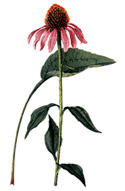
Echinacea
Introduction
This fact sheet provides basic information about the herb plant or part of a plant used for its flavor, scent, or potential therapeutic properties. Includes flowers, leaves, bark, fruit, seeds, stems, and roots. echinacea-common names, uses, potential side effects, and resources for more information. There are nine known species of echinacea, all of which are native to the United States and southern Canada. The most commonly used, Echinacea purpurea, is believed to be the most potent.Common Names
echinacea, purple coneflower, coneflower, American coneflowerLatin Names
Echinacea purpurea, Echinacea angustifolia, Echinacea pallidaWhat It Is Used For
- Echinacea has traditionally been used to treat or prevent colds, flu, and other infections.
- Echinacea is believed to stimulate the immune system to help fight infections.
- Less commonly, echinacea has been used for wounds and skin problems, such as acne or boils.
How It Is Used
The aboveground parts of the plant and roots of echinacea are used fresh or dried to make teas, squeezed (expressed) juice, extracts, or preparations for external use.What the Science Says
- Study results are mixed on whether echinacea effectively treats colds or flu. For example, two NCCAM-funded studies did not find a benefit from echinacea, either as Echinacea purpurea fresh-pressed juice for treating colds in children, or as an unrefined mixture of Echinacea angustifolia root and Echinacea purpurea root and herb in adults. However, other studies have shown that echinacea may be beneficial in treating upper respiratory infections.
- Most studies to date indicate that echinacea does not appear to prevent colds or other infections.
- NCCAM is continuing to support the study of echinacea for the treatment of upper respiratory infections. NCCAM is also studying echinacea for its potential effects on the immune system.
Side Effects and Cautions
- When taken by mouth, echinacea usually does not cause side effects. However, some people experience allergic reactions, including rashes, increased asthma, and anaphylaxis (a life-threatening allergic reaction). In clinical trials, gastrointestinal side effects were most common.
- People are more likely to experience allergic reactions to echinacea if they are allergic to related plants in the daisy family, which includes ragweed, chrysanthemums, marigolds, and daisies. Also, people with asthma or atopy (a genetic tendency toward allergic reactions) may be more likely to have an allergic reaction when taking echinacea.
- Tell your health care providers about any complementary and alternative practices you use. Give them a full picture of what you do to manage your health. This will help ensure coordinated and safe care.
Sources
- Barrett BP, Brown RL, Locken K, et al. Treatment of the common cold with unrefined echinacea: a randomized, double-blind, placebo-controlled trial. Annals of Internal Medicine. 2002;137(12):939-946.
- Echinacea. Natural Medicines Comprehensive Database Web site. Accessed June 29, 2007.
- Echinacea (E. angustifolia DC, E. pallida, E. purpurea). Natural Standard Database Web site. Accessed June 28, 2007.
- Echinacea. In: Blumenthal M, Goldberg A, Brinckman J, eds. Herbal Medicine: Expanded Commission E Monographs. Newton, MA: Lippincott Williams & Wilkins; 2000:88-102.
- Fugh-Berman A. Echinacea for the prevention and treatment of upper respiratory infections. Seminars in Integrative Medicine. 2003;1(2):106-111.
- Taylor JA, Weber W, Standish L, et al. Efficacy and safety of echinacea in treating upper respiratory tract infections in children: a randomized controlled trial. Journal of the American Medical Association. 2003;290(21):2824-2830.
- NCCAM National Institutes of Health






